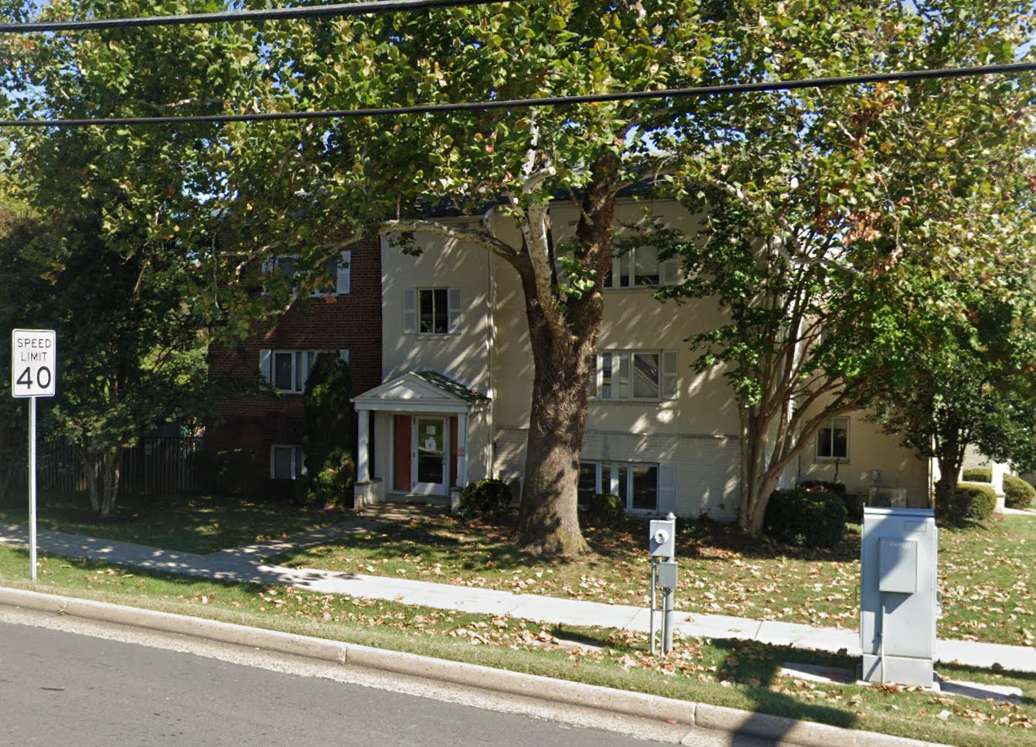
(Updated at 3:35 p.m.) Congress has passed another short-term budget package, averting a partial shutdown of the federal government just hours before a midnight deadline.
In addition to funding the Justice Department, Housing and Urban Development, and other key agencies, the slate of bills passed 75-22 by the Senate on Friday (March 8) includes $12.7 billion in “pork” — money designated for local projects requested by lawmakers for their constituents.
In a joint press release, Sens. Tim Kaine and Mark Warner announced that Fairfax County and other Virginia localities will be among the beneficiaries of the more than 6,600 projects that got funding, per the Associated Press.
“I’m proud that we secured funding for 105 community projects across Virginia that will improve transportation, upgrade water infrastructure, support health care, and more,” Kaine said. “I urge Congress to take up the rest of the government funding bills as soon as possible.”
According to breakdowns provided by Warner’s and Rep. Gerry Connolly’s offices, the biggest allocation for Fairfax County is $4.1 million “to fund a new homeless and domestic violence shelter for families.”
The county’s existing domestic violence and family shelters have exceeded their useful lives, but instead of building new facilities, the Fairfax County Redevelopment and Housing Authority is planning to convert an existing “extended stay” hotel that will be able to house about 50 families a day.
“Site acquisition activities are ongoing, with the goal of securing a location that is well-served by transit, and close to jobs and services,” FCRHA spokesperson Allyson Pearce said.
Connolly’s office says the site “will entail combining rooms, creating service and office space, and other changes to the existing hotel setup,” noting that converting an existing building instead of constructing a new one will enable the county “to deliver this essential, brand new facility years earlier than might otherwise be accomplished.”
The county has two shelters specifically for people fleeing domestic violence — Artemis House and Bethany House — and two shelters that accommodate people with children — the Katherine Hanley shelter outside Centreville and the Patrick Henry shelter in Seven Corners.
The Fairfax County Board of Supervisors approved plans in August 2022 to replace the Patrick Henry shelter with supportive housing after some delays related to land acquisition challenges.
The appropriations package also includes funding for several road and pedestrian projects:
- Spring Street widening from four to six lanes between Herndon Parkway and Fairfax County Parkway ($1 million)
- Fox Mill Road and Pinecrest Road intersection improvements in Herndon ($850,000)
- Silverbrook Road and Lorton Road intersection improvements ($850,000)
- Sidewalk on Ninian Avenue and along Bush Hill Drive to improve safety and accessibility for Bush Hill Elementary School students in Rose Hill ($850,000)
- Gunston Road shared-use path from Julia Taft Way to the Pohick Bay Golf Course entrance in Lorton ($500,000)
- Compton Road bicycle and pedestrian path from the Bull Run Special Events Center access road to the Cub Run Stream Valley Trail in Centreville ($500,000)
- Stone Road trail from the I-66 interchange to an existing trail along southbound Route 28 in Centreville ($500,000)
The Fairfax County Department of Transportation applied for federal grants last summer to fund the Bush Hill and Compton Road projects. Read More
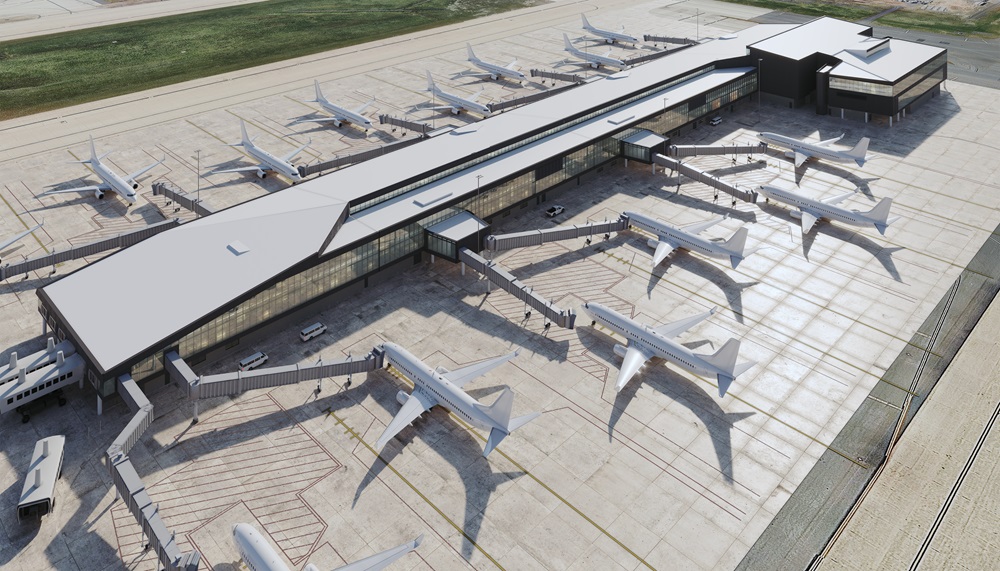
A planned 14-gate concourse at Dulles International Airport received a major federal lift this week.
Yesterday, Senators Mark Warner and Tim Kaine announced that the Tier 2 Concourse East project will get $35 million in funding from the Bipartisan Infrastructure Law that Congress passed in 2021.
The funds will help finance the 400,000-square-foot terminal building, which will provide a direct connection to the Aerotrain that helps customers move around the airport and a direct connection to Metro’s Silver Line station at Dulles.
“Dulles Airport is a beacon for both domestic and international flights, and has expanded rapidly over the past decade,” the senators said in a statement. “This funding will improve travel for passengers and ensure that the airport stays functional and safe while continuing to meet flight demands.”
The project broke ground in November, and preliminary construction activities are underway, Metropolitan Washington Airports Authority (MWAA) spokesperson Crystal Nosal confirmed.
“This project will be a significant step in upgrading aging facilities at the airport to enhance customer service and meet future infrastructure needs,” Nosal wrote in a statement.
A complete timeline for the estimated date of completion was not immediately available.
In its statement, MWAA said it was appreciative of the federal funds to support the concourse project, which is projected to cost between $500 million and $800 million in total.
MWAA announced in April 2022 that it had applied for $230 million in Federal Aviation Administration grant funding from a program created by the Bipartisan Infrastructure Law to help airports upgrade or replace aging facilities.
“We are grateful to our partners at United Airlines and members of the Northern Virginia congressional delegation as well as officials in the Commonwealth of Virginia and local governments for their strong support of this effort,” MWAA said. “We also thank regional business groups for their support in this grant process.”
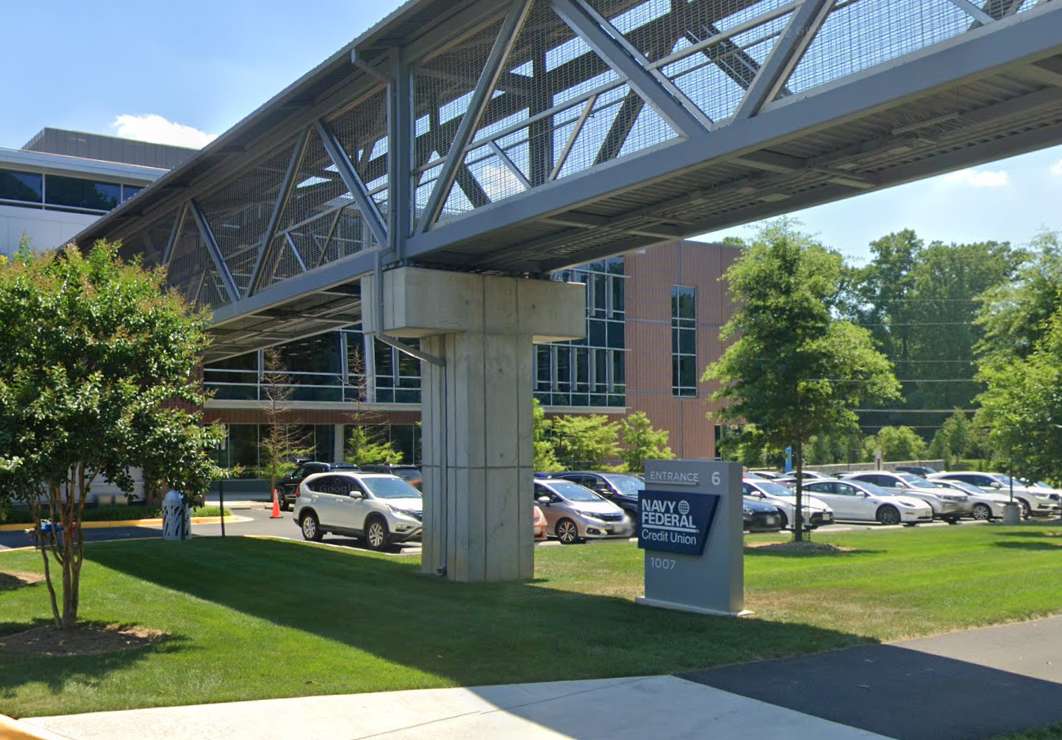
Virginia Sen. Tim Kaine is calling on the federal government to investigate whether Navy Federal Credit Union has discriminated when approving loans to homebuyers.
The country’s largest credit union, which is headquartered in Vienna, rejected more than half of the Black people who sought a conventional home purchase mortgage in 2022, despite approving over 75% of white borrowers seeking the same loan, CNN reported last month.
Hispanic applicants also got approved just 56% of the time compared to 77% for their white counterparts, according to the report, which was based on data from the Consumer Financial Protection Bureau (CFPB).
The disparities, which exceed those reported by other major lenders, suggest Navy Federal’s practices may violate prohibitions on discrimination in the Fair Housing Act and the Equal Credit Opportunity Act (ECOA), Kaine and other senators wrote in a Jan. 12 letter urging a review by the CFPB and Department of Housing and Urban Development (HUD).
“While it is appropriate for a lender to deny a mortgage application when the loan will not be sustainable for the borrower, those decisions are made based on a borrower’s financial ability to repay the loan,” the senators said. “It should go without saying that a person’s race, or any other protected characteristic, should never be a factor.”
Founded in 1933 to provide loans to Navy Department employees, Navy Federal has grown to 13 million members and now serves all branches of the military, along with Department of Defense civilians, veterans and their families. The not-for-profit credit union has over 350 branches around the world and employs more than 4,000 people at its headquarters (820 Follin Lane), according to its website.
A spokesperson for Navy Federal Credit Union said the organization has “already initiated a review to assess our mortgage lending policies and practices,” noting that more of its conventional mortgage loans go to Black borrowers — about 18%, per CNN — than most other large lenders.
However, CNN reported that most Black applicants are still getting denied, and the racial disparities persisted even when variables like income, property value and neighborhood characteristics were the same.
“Navy Federal is committed to serving each and every one of our members fairly, and we strive every day to expand economic opportunity and access to credit for our diverse community of members,” the Navy Federal spokesperson said. “…We will continue to work to support all of our members — including Black borrowers — to help them build strong financial futures.”
Homeownership emerged in the post-World War II years as a critical path for accumulating wealth. Over the past 10 years, homeowners have gained anywhere from $98,900 to $150,800 in wealth from rising home values, depending on their income, according to a National Association of Realtors report.
However, Black and Hispanic residents have often been excluded by segregation, redlining and other discriminatory practices, leading to the creation of the 1968 Fair Housing Act, which prohibits discrimination based on race, gender, disability and other identity factors.
The legislation helped narrow the gap between white and Black homeowners, but those gains were erased by the 2008 recession, according to Urban Institute. The Metropolitan Washington Council of Governments announced last week that Fairfax County is among eight localities that have adopted a Regional Fair Housing Plan intended to improve access to housing.
In a press release, Kaine noted that he, fellow Virginia Sen. Mark Warner and other senators introduced legislation last July to reduce the wealth gap by helping first-time, first-generation homebuyers get mortgages.
Image via Google Maps
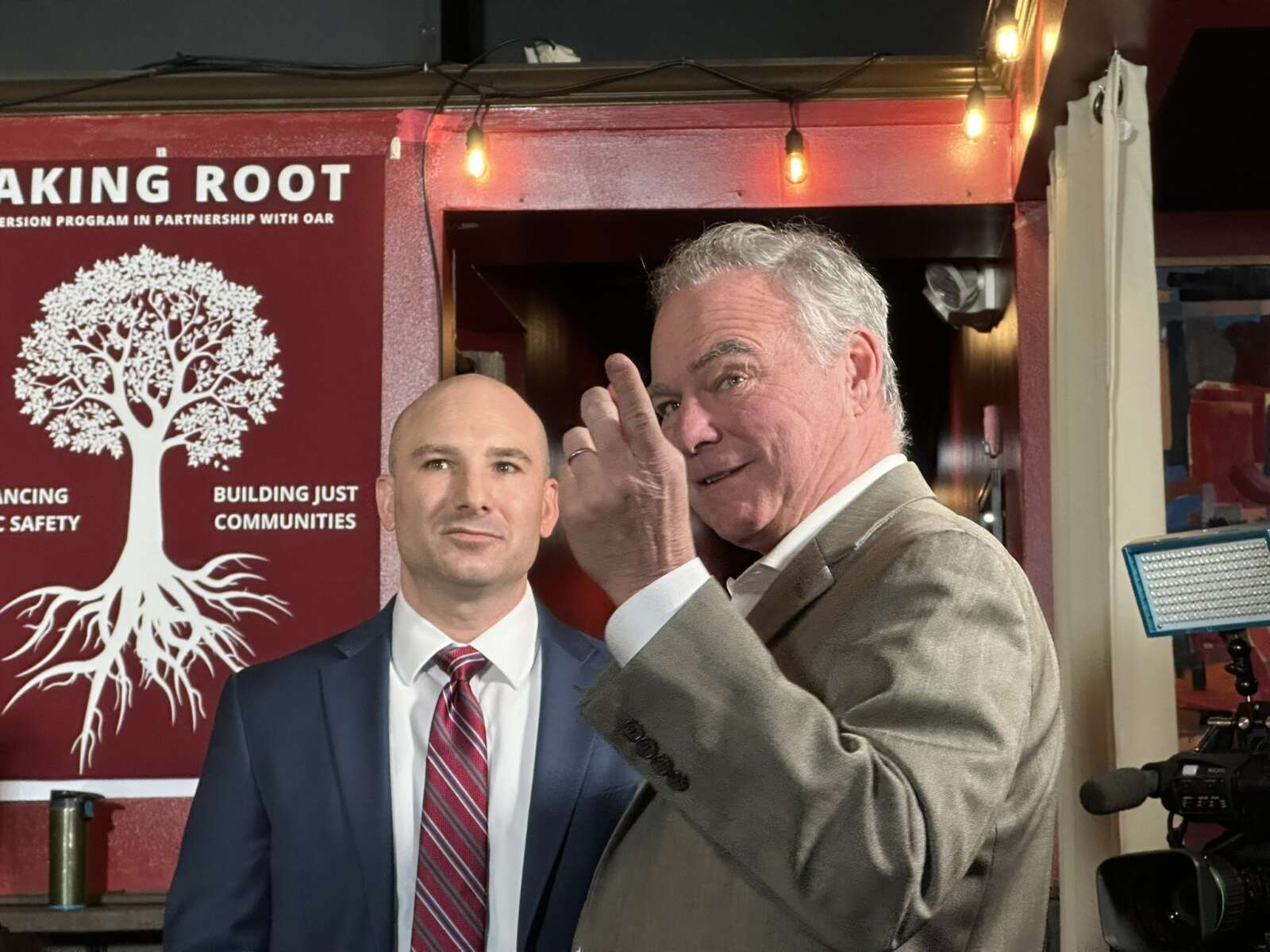
Instead of jail-time, a restaurant job could be waiting for some individuals facing non-violent criminal charges in Fairfax County if they finish a newly launched job training program.
The Pathfinder Kitchen initiative unveiled Monday (Jan. 8) by the Fairfax County Office of the Commonwealth’s Attorney builds on the office’s nascent Taking Root diversion program, which offers case management, mental health and substance use assessments, affordable housing and other services to people accused of non-violent crimes in lieu of incarceration.
Starting this spring, participants will get an opportunity to learn culinary skills at Mackenzie’s Tunes and Tonics, which opened in Fairfax City last June, and earn the certification needed to work in the food service industry.
Like the county’s other diversion programs, Taking Root and its new culinary training option are designed to address the underlying causes of crime — in this case, poverty and barriers to employment — so individuals who’ve entered the criminal justice system are less likely to return.
“Pathfinder Kitchen is actually the next generation of that, actually getting people into restaurant training with certificates so they can get a job and build a career,” Commonwealth’s Attorney Steve Descano said. “That’s really, really important for public safety. It’s also the right thing to do.”
Launched in April 2022 by the prosecutors’ office and the nonprofit Opportunities, Alternatives & Resources (OAR), Taking Root focuses on people charged with a non-violent offense who are experiencing an “underlying issue,” such as poverty or drug addiction, that could be eased with treatment or social services.
Descano says his office doesn’t have “hard and fast” eligibility rules for determining who to recommend for the program, but most participants are on their first or second time in the court system, and their diversion plan must be approved by a judge.
So far, 100 people have been referred to Taking Root, and 20 of them have graduated — a milestone that the Commonwealth’s Attorney’s Office, OAR and other supporters, including Sen. Tim Kaine, celebrated at Mackenzie’s (3950 University Drive, Suite 210) on Monday.
According to Descano, the idea for Pathfinder Kitchen was developed with Mackenzie’s owner Josh Alexander, who also chairs the Old Town Fairfax Business Association (OTFBA) board of directors.
“He was telling us about the need to get more people into the restaurant business, into the industry, and we just started to…have this dialogue and said, ‘Hey, we have a crop of people who [could help], if you’re willing to give people second chances’…and they were very receptive,” Descano recalled.
Also supported by the nonprofit Britepaths, which provides supportive services, the pilot program is funded by a Fairfax City grant, and graduates who get their ServSafe certification will be placed in jobs with participating restaurants, all of which are currently in the city.
Reflecting on Taking Root’s first full year of operations, OAR Diversion Program Manager Lula Kelly said the ability to work with each participant based on their specific needs is key to the program’s success. Read More
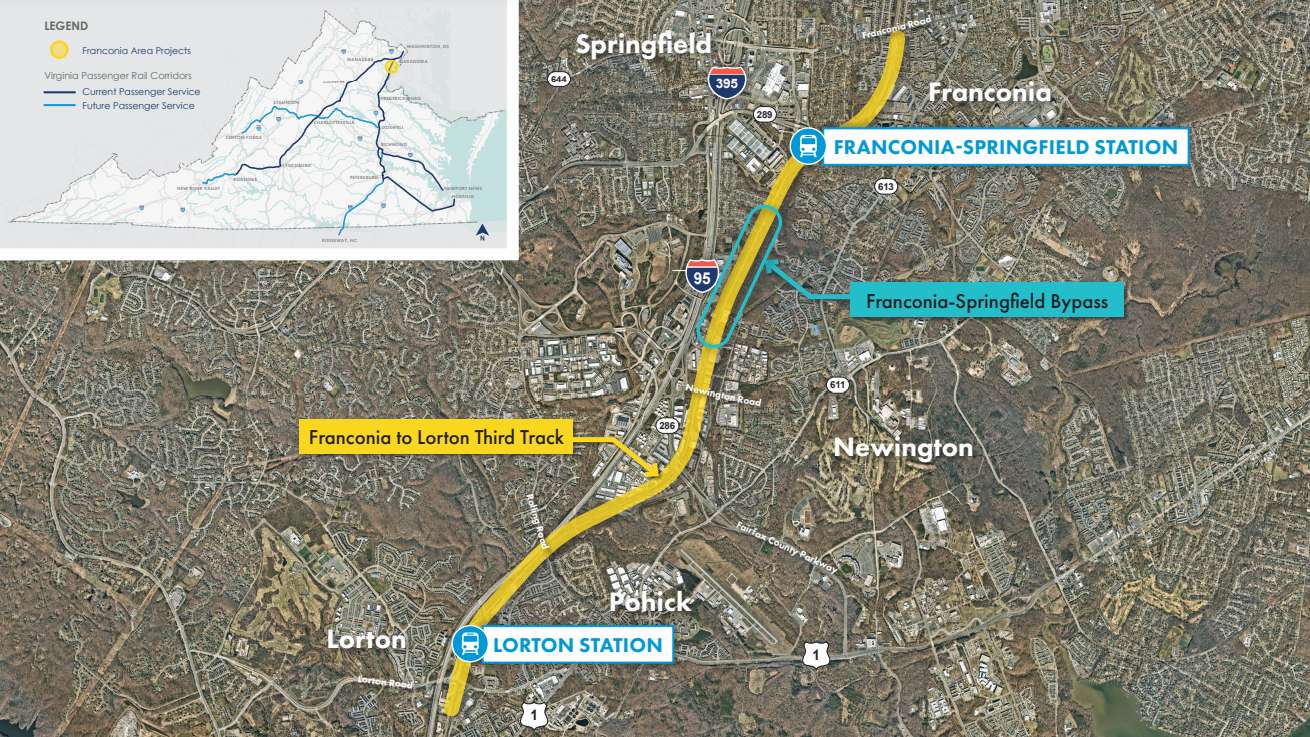
(Updated at 6 p.m.) A project to enhance the capacity of a key rail line through Fairfax County is chugging along, thanks to a major infusion of federal cash.
The Virginia Passenger Rail Authority has been awarded $100 million in federal funds to design and build a bridge that will allow Virginia Railway Express and Amtrak trains to cross over tracks approaching the Franconia-Springfield station (6880 Frontier Drive), Sens. Tim Kaine and Mark Warner announced yesterday (Thursday).
The bridge will relieve congestion and open up the possibility of additional passenger and freight service on the railway, which is one of Virginia’s busiest, according to the senators.
“Passenger rail is a vital connector for so many Virginians — carrying people to their work, their families, and their travel plans,” Warner and Kaine said in a joint statement. “We’re thrilled to see this funding make rail safer and more efficient for Virginians by addressing a critical chokepoint in a vital location, alleviating congestion for hundreds of Virginians every single day.”
Under development since 2021, the Franconia-Springfield Bypass will consist of a roughly 1-mile-long bridge that will carry passenger trains over two existing tracks for CSX freight trains just south of the rail station, VPRA officials said at a neighborhood meeting in July.
The bridge will have just one track, but it will be built to accommodate a future second track.
The project is part of a larger push by Virginia to improve its rail service between Fredericksburg and D.C. Other projects include an extension of a third track that currently starts in Alexandria for about six miles from Franconia to Lorton.
“Expanding passenger rail as an alternative to interstate travel is critical as traffic congestion in Northern Virginia continues to grow at an unsustainable rate,” VPRA Executive Director DJ Stadtler said. “Building the Franconia-Springfield Bypass will allow us to expand our state-supported rail service by alleviating train interference at the most congested point in Virginia…The bypass is key to providing Virginians with reliable, consistent, and convenient passenger rail service.”
According to VPRA, engineering on the bypass is scheduled to begin this year, with construction potentially kicking off in 2024 and finishing in 2026. VPRA has budgeted $405 million overall for the project, a spokesperson says.
The new federal funding comes from the Bipartisan Infrastructure Investment and Jobs Act that President Joe Biden signed into law on Nov. 15, 2021 and a fiscal year 2022 spending package, Warner’s office said.
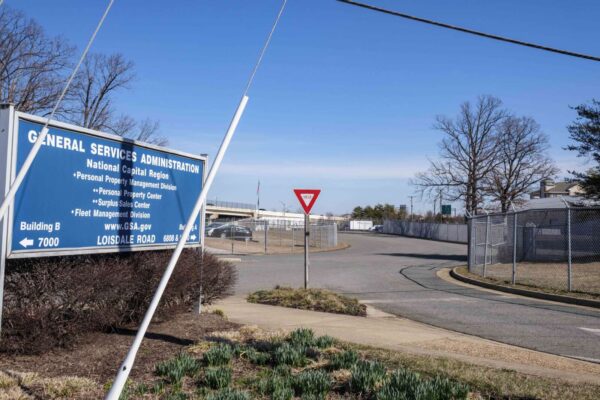
There has been another change in criteria for determining where the new FBI headquarters will go, prompting annoyance and even anger from several local officials.
Late last week, the General Services Administration (GSA) announced that it will now weigh cost and “advancing equity” as factors of higher importance when deciding if the new FBI headquarters will end up in Springfield or one of two sites in Prince George’s County, Maryland, per an updated site selection plan.
“The consultations with the delegations provided valuable feedback, and helped us refine our plan to maximize value for the FBI and the public,” said GSA commissioner Nina Albert in a press release. “While the core elements of the site selection plan remain the same, we have updated the plan to incorporate new government-wide directives and to increase the consideration of cost to deliver better value for taxpayers. We believe these adjustments will support a process that results in a site that best serves the FBI and the public for years to come.”
The federal agency also lowered the importance of transportation accessibility and the proximity of being near other FBI facilities (like Quantico, which is in Virginia). Proximity remains the highest determining factor, though, sitting at 25%.
This is the second time in less than a year that the GSA “updated” its criteria for selecting the location of the new headquarters. It also comes a little over a month after the FBI stressed the importance of having a headquarters close to its pre-existing facilities.
GSA anticipates making a decision on where the new FBI headquarters will go “in the coming months,” the press release notes. Some had anticipated a decision was going to be announced in March, but that didn’t happen.
The late-stage shift has prompted a number of Virginia lawmakers to speak out, arguing that this change is a result of political inference and constant lobbying from Maryland officials seeking to gain an edge for the Prince George’s sites.
Rep. Gerry Connolly, whose 11th District includes the Springfield site, was particularly incensed. In a statement posted on social media, Connolly accused Maryland of trying to “cook the books” and the GSA of caving to political pressure.
Only Virginia has consistently opposed and condemned political meddling in what should be a purely independent, agency-run effort. We will continue to make the case for the only location that truly makes sense for the FBI HQ – Springfield, Virginia. pic.twitter.com/WqdGZNM6H7
— Rep. Gerry Connolly (@GerryConnolly) July 14, 2023
Virginia Sens. Tim Kaine and Mark Warner put out a combined statement reiterating their confidence that the FBI will still end up moving to Fairfax County, coupled with worries that the change will further delay a decision that’s been in the works for years.
The GSA didn’t pluck its initial criteria out of thin air — it spent years talking to experts and carefully deliberating on what is best for the mission of the FBI. While we are concerned that these changes to the criteria will further delay what has already been a drawn-out, decade-long process to select a new site to replace the dilapidated headquarters downtown, we remain confident that Virginia continues to be a home run in every category, and encourage the GSA to draw this process to a close sooner rather than later.
In a statement to FFXnow, Fairfax County Board of Supervisors Chairman Jeff McKay also expressed his displeasure, particularly with the likelihood of another delay of a final decision. Read More
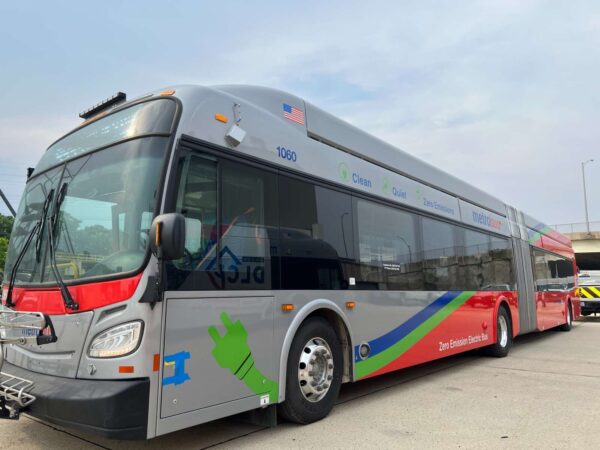
Metro’s bus facility in Franconia is a step closer to going electric, thanks to a big infusion of funding from the federal government.
The Federal Transit Administration has awarded Metro a $104 million grant to convert its Cinder Bed Road Bus Division garage at 7901 Cinder Bed Road into a fully electric facility, the Washington Metropolitan Area Transit Authority announced Monday (June 26).
In addition to supporting new charging infrastructure, the funds will enable Metro to buy about 100 battery-powered buses and develop a training program for drivers, mechanics and first responders, according to Sens. Mark Warner and Tim Kaine, who lauded the grant in a joint statement.
“We appreciate the Federal Transit Administration’s leadership in the transition to zero-emission bus technology that will help reduce air pollution and improve quality of life across the region,” WMATA Board Chair Paul Smedberg said, thanking the senators and other federal, state and local elected officials for helping secure the money.
Metro’s board of directors adopted a plan in 2021 directing the transit agency to purchase only buses that don’t produce carbon emissions by 2030 and fully transition to a zero-emission bus fleet by 2045.
Metro’s first electric bus arrived this month as part of an initial 12-vehicle batch that will operate out of the Shepherd Parkway garage in D.C., according to WMATA. The vehicles were expected earlier, but the delivery got delayed after a fire in Connecticut last summer forced the manufacturer New Flyer to recall hundreds of buses.
Located northeast of the I-95 and Fairfax County Parkway interchange, the Cinder Bed Road garage houses 121 40-foot buses that serve 11 routes, as of December 2021. It has parking for 160 vehicles and 13 maintenance bays.
According to Metro’s transition plan, the facility could host 112 battery-powered electric buses. It has “safe and efficient site circulation,” but a stacked bus parking layout and existing underground infrastructure for utilities and stormwater pose hurdles.
To fully cover the cost of converting the Cinder Bed garage, the federal grant will be matched by “a combination of local funding,” a Metro spokesperson said.
Fairfax County plans to use the facility for its future Richmond Highway bus rapid transit service. Branded as The One, the system will operate all-electric buses from Fort Belvoir to the Huntington Metro station, potentially beginning in 2030.
“Thanks to our partnership with the Washington Metropolitan Area Transit Authority and federal support, we will soon deliver a fully converted battery-electric bus facility in Fairfax County,” Fairfax County Board of Supervisors Chairman Jeff McKay said. “This project aligns with the county’s important goal of carbon neutral government operations by 2040 and is an investment in the region’s transit system and clean energy that will bring significant environmental and community benefits.”
The conversion design process is slated to begin later this year, with a projected opening coming in 2027-2028, according to WMATA’s transition plan. Read More
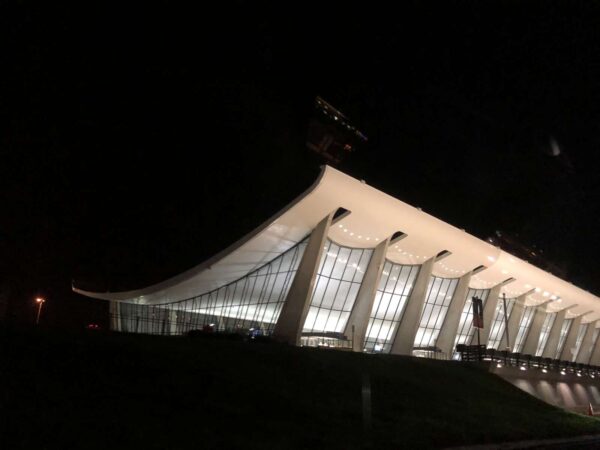
A proposal for more long-distance flights at Reagan National Airport (DCA) is catching the ire of some of Virginia’s Congressional representatives, who say it could undermine efforts to grow Dulles International Airport (IAD).
Proponents led by Capital Access Alliance argue that current restrictions at Reagan National — an airport owned by the federal government — are outdated and hurt the economy. They want to increase the number of flights that travel beyond 1,250 miles from the airport, allowing as many as 25 daily round trips.
According to the Alliance:
Since the late 1960s, Ronald Reagan Washington National Airport (DCA) has been the only airport subject to a federally imposed perimeter rule, which limits the number of flights that are allowed to take-off and land outside a 1,250-mile perimeter. However, the consumer, economic, technological and industry landscape has changed substantially in the last 60 years, and the rule’s original goals no longer apply to today’s air travel ecosystem in the nation’s capital.
The group released a study by Boston Consulting Group that argues more long-distance flights would boost all airlines equally, reduce ticket prices for passengers, and result in millions of dollars in economic growth.
But senators who represent Virginia and Maryland say that the proposal will undermine Dulles, just as more customers may utilize the airport due to the arrival of Metro last year.
In a joint statement issued last Wednesday (April 26), Sens. Mark Warner and Tim Kaine said that past efforts to allow exceptions to the perimeter pool have “produced significant stress” on the airport.
“Those changes have also prevented Dulles, whose size allows for larger planes to land and take off, from realizing its full potential as the primary long-haul flight destination for the Washington metropolitan area,” the statement reads.
According to the letter, Reagan National is now seeing more travelers than Dulles, even though the international airport was designed for more capacity.
For over a decade, traffic at DCA has risen sharply, while IAD has declined or stagnated in the same measures. In 2010, total annual enplanements at IAD exceeded those at DCA by more than 5 million. At the end of 2019, before COVID-19 upended the national aviation industry, IAD outpaced DCA by less than a million passengers annually. Now, as we begin to emerge from the pandemic and Americans return to travel, this pattern has worsened. Today, IAD trails DCA by more than 1 million.
The senators go on to argue that loosening the slot and perimeter rules threatened the balance between the airports.
“As Congress prepares to reauthorize the Federal Aviation Administration (FAA), we will strongly oppose any efforts to disrupt or undermine the balance between Dulles and National, an airport one-fourteenth the size of Dulles,” the statement said.
Warner wrote a similar letter to the U.S. Senate Committee on Commerce Science and Transportation in March.
Congress is expected to take up the FAA’s reauthorization bill this fall.

More than two decades after he graduated, astronaut Dr. Kjell Lindgren has been drawn back into Robinson Secondary School’s orbit.
The Fairfax school will welcome its Class of 1991 alum back this afternoon (Friday) for a student assembly, where Lindgren will be joined on stage by NASA Administrator Bill Nelson and Virginia Sen. Tim Kaine.
After helping secure $103 million in federal funding to replace the Wallops Island Bridge linking NASA’s Wallops Flight Facility to mainland Virginia, Kaine has been tasked with delivering introductory remarks before participating in a question-and-answer session, according to his office.
“I’m really looking forward to heading to Robinson Secondary School…to connect with students there and hear more about Dr. Lindgren’s experience in space and learn about NASA’s recent work,” Kaine said in a statement to FFXnow. “It’s my hope that this event will help inspire a new generation of astronauts and researchers from Virginia, and I appreciate Dr. Lindgren taking the time to share his story at his alma mater.”
Since graduating from Robinson, Lindgren has notched some out-of-this-world accomplishments, per his NASA bio.
Selected as one of 14 members of NASA’s 20th astronaut class in 2009, he now has 311 days in space and two spacewalks under his belt. That experience came as a crew member on the agency’s 44th and 45th expeditions to the International Space Station in 2015, and as commander of its SpaceX Crew-4 mission.
Lindgren and three other crew members in that mission — NASA’s fourth commercial flight overall and first in the “Freedom” capsule manufactured by Elon Musk’s private company — splashed back down to Earth on Oct. 14, 2022 after 170 days in orbit.
During his time in space, Lindgren helped conduct hundreds of scientific experiments that dealt with subjects like growing crops in space and the impact of life in microgravity on hearing, according to NASA. As part of Expedition 44, he was among the first people to eat lettuce grown in space.
A native of Taipei, Taiwan, Lindgren grew up in the Midwest and England before moving to Virginia for his last three years of high school. His parents still live in Burke.
For his undergraduate education, he attended the U.S. Air Force Academy, serving as an instructor and jumpmaster for the school’s “Wings of Blue” parachuting team. He later went to medical school and got certified in emergency medicine, supporting NASA as a flight surgeon before becoming an astronaut.
Photo courtesy NASA/Flickr

In an unusual show of bipartisan unity, Republican Gov. Glenn Youngkin will attend a press conference tomorrow (Wednesday) with Democratic senators Mark Warner and Tim Kaine and other elected leaders to rally for a Northern Virginia FBI headquarters.
A release from Warner’s office said the elected leaders will hold a press conference in Springfield to lay out the case for bringing the proposed headquarters to Fairfax County.
According to the release:
The press conference comes as the FBI and the General Services Administration (GSA) work to finalize a location for the new headquarters after years of work on the project spanning multiple presidential administrations.
The press conference follows a letter from the Commonwealth’s congressional delegation and Gov. Youngkin, detailing the ways in which Springfield best meets the five selection criteria set forth by the GSA and FBI, which are: support for the FBI mission requirement; transportation access; site development flexibility; promoting sustainable siting and advancing equity; and cost.
The bidding war over the FBI headquarters is possibly the most intense skirmish between Virginia and Maryland since 1865. Virginia is hoping to bring the FBI to a 58-acre site in Springfield, while Maryland is hoping to draw the FBI to Landover or Greenbelt.
The lineup looks like Coachella for Fairfax County elected leadership, with representatives Gerry Connolly, Don Beyer and Abigail Spanberger joining Youngkin and the senators, along with Fairfax County Board of Supervisors Chairman Jeff McKay, Franconia District Supervisor Rodney Lusk, and representatives from other local organizations.
McKay previously accused Washington Metropolitan Area Transit Authority (WMATA) — multiple times — of unfairly trying to tip the scales in favor of the FBI purchasing a Maryland site currently owned by WMATA. Maryland, meanwhile, has argued that proximity to Quantico is being too heavily weighted in favor of Virginia.
The Board of Supervisors approved its own letter to the GSA and FBI last week advocating for the Springfield site, which currently a warehouse for the GSA right next to the agency’s headquarters.
The press conference is scheduled for 8:45 a.m. at Northern Virginia Community College (6699 Springfield Center Drive).

